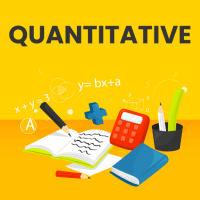Quant Exam > Quant Questions > Two baskets contain 183 and 242 Apples respec...
Start Learning for Free
Two baskets contain 183 and 242 Apples respectively, which are distributed in equal number among children. Find the largest number of apples that can be given, so that 3 apples are left over from the first basket and 2 from the second.
- a)45
- b)40
- c)60
- d)56
- e)None of these
Correct answer is option 'C'. Can you explain this answer?
Verified Answer
Two baskets contain 183 and 242 Apples respectively, which are distrib...
183-3 = 180
142-2 = 240
HCF of 240, 180 = 60
Most Upvoted Answer
Two baskets contain 183 and 242 Apples respectively, which are distrib...
Problem: Two baskets contain 183 and 242 Apples respectively, which are distributed in equal number among children. Find the largest number of apples that can be given, so that 3 apples are left over from the first basket and 2 from the second.
To solve this problem, we need to find the HCF (Highest Common Factor) of 183 and 242.
Step-by-Step Solution:
1. Find the factors of 183 and 242.
Factors of 183: 1, 3, 61, 183
Factors of 242: 1, 2, 11, 22, 121, 242
2. Identify the common factors of 183 and 242.
Common factors: 1
3. Find the highest common factor (HCF) of 183 and 242.
HCF: 1
4. Subtract the remainders (3 and 2) from the HCF.
HCF - 3 - 2 = 1 - 3 - 2 = -4
5. Divide the sum of the fruits (183 + 242) by the HCF minus the remainders.
(183 + 242) / -4 = -105.25
Since the number of apples cannot be negative, we must take the absolute value of the result, which is 105.25. Therefore, the largest number of apples that can be given is 105.
To verify that this is the correct answer, we can divide both baskets equally among the children and check if there are 3 apples left over from the first basket and 2 from the second.
Each child gets 105 apples, and the remaining apples are:
183 - (105*1) = 78 (remainder of 3)
242 - (105*2) = 32 (remainder of 2)
Therefore, the answer is (C) 60.
To solve this problem, we need to find the HCF (Highest Common Factor) of 183 and 242.
Step-by-Step Solution:
1. Find the factors of 183 and 242.
Factors of 183: 1, 3, 61, 183
Factors of 242: 1, 2, 11, 22, 121, 242
2. Identify the common factors of 183 and 242.
Common factors: 1
3. Find the highest common factor (HCF) of 183 and 242.
HCF: 1
4. Subtract the remainders (3 and 2) from the HCF.
HCF - 3 - 2 = 1 - 3 - 2 = -4
5. Divide the sum of the fruits (183 + 242) by the HCF minus the remainders.
(183 + 242) / -4 = -105.25
Since the number of apples cannot be negative, we must take the absolute value of the result, which is 105.25. Therefore, the largest number of apples that can be given is 105.
To verify that this is the correct answer, we can divide both baskets equally among the children and check if there are 3 apples left over from the first basket and 2 from the second.
Each child gets 105 apples, and the remaining apples are:
183 - (105*1) = 78 (remainder of 3)
242 - (105*2) = 32 (remainder of 2)
Therefore, the answer is (C) 60.

|
Explore Courses for Quant exam
|

|
Question Description
Two baskets contain 183 and 242 Apples respectively, which are distributed in equal number among children. Find the largest number of apples that can be given, so that 3 apples are left over from the first basket and 2 from the second.a)45b)40c)60d)56e)None of theseCorrect answer is option 'C'. Can you explain this answer? for Quant 2025 is part of Quant preparation. The Question and answers have been prepared according to the Quant exam syllabus. Information about Two baskets contain 183 and 242 Apples respectively, which are distributed in equal number among children. Find the largest number of apples that can be given, so that 3 apples are left over from the first basket and 2 from the second.a)45b)40c)60d)56e)None of theseCorrect answer is option 'C'. Can you explain this answer? covers all topics & solutions for Quant 2025 Exam. Find important definitions, questions, meanings, examples, exercises and tests below for Two baskets contain 183 and 242 Apples respectively, which are distributed in equal number among children. Find the largest number of apples that can be given, so that 3 apples are left over from the first basket and 2 from the second.a)45b)40c)60d)56e)None of theseCorrect answer is option 'C'. Can you explain this answer?.
Two baskets contain 183 and 242 Apples respectively, which are distributed in equal number among children. Find the largest number of apples that can be given, so that 3 apples are left over from the first basket and 2 from the second.a)45b)40c)60d)56e)None of theseCorrect answer is option 'C'. Can you explain this answer? for Quant 2025 is part of Quant preparation. The Question and answers have been prepared according to the Quant exam syllabus. Information about Two baskets contain 183 and 242 Apples respectively, which are distributed in equal number among children. Find the largest number of apples that can be given, so that 3 apples are left over from the first basket and 2 from the second.a)45b)40c)60d)56e)None of theseCorrect answer is option 'C'. Can you explain this answer? covers all topics & solutions for Quant 2025 Exam. Find important definitions, questions, meanings, examples, exercises and tests below for Two baskets contain 183 and 242 Apples respectively, which are distributed in equal number among children. Find the largest number of apples that can be given, so that 3 apples are left over from the first basket and 2 from the second.a)45b)40c)60d)56e)None of theseCorrect answer is option 'C'. Can you explain this answer?.
Solutions for Two baskets contain 183 and 242 Apples respectively, which are distributed in equal number among children. Find the largest number of apples that can be given, so that 3 apples are left over from the first basket and 2 from the second.a)45b)40c)60d)56e)None of theseCorrect answer is option 'C'. Can you explain this answer? in English & in Hindi are available as part of our courses for Quant.
Download more important topics, notes, lectures and mock test series for Quant Exam by signing up for free.
Here you can find the meaning of Two baskets contain 183 and 242 Apples respectively, which are distributed in equal number among children. Find the largest number of apples that can be given, so that 3 apples are left over from the first basket and 2 from the second.a)45b)40c)60d)56e)None of theseCorrect answer is option 'C'. Can you explain this answer? defined & explained in the simplest way possible. Besides giving the explanation of
Two baskets contain 183 and 242 Apples respectively, which are distributed in equal number among children. Find the largest number of apples that can be given, so that 3 apples are left over from the first basket and 2 from the second.a)45b)40c)60d)56e)None of theseCorrect answer is option 'C'. Can you explain this answer?, a detailed solution for Two baskets contain 183 and 242 Apples respectively, which are distributed in equal number among children. Find the largest number of apples that can be given, so that 3 apples are left over from the first basket and 2 from the second.a)45b)40c)60d)56e)None of theseCorrect answer is option 'C'. Can you explain this answer? has been provided alongside types of Two baskets contain 183 and 242 Apples respectively, which are distributed in equal number among children. Find the largest number of apples that can be given, so that 3 apples are left over from the first basket and 2 from the second.a)45b)40c)60d)56e)None of theseCorrect answer is option 'C'. Can you explain this answer? theory, EduRev gives you an
ample number of questions to practice Two baskets contain 183 and 242 Apples respectively, which are distributed in equal number among children. Find the largest number of apples that can be given, so that 3 apples are left over from the first basket and 2 from the second.a)45b)40c)60d)56e)None of theseCorrect answer is option 'C'. Can you explain this answer? tests, examples and also practice Quant tests.

|
Explore Courses for Quant exam
|

|
Signup for Free!
Signup to see your scores go up within 7 days! Learn & Practice with 1000+ FREE Notes, Videos & Tests.


















